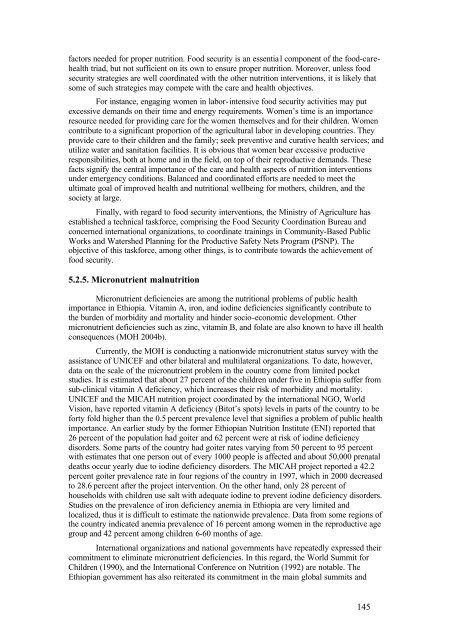An assessment of the causes of malnutrition in Ethiopia: A ...
An assessment of the causes of malnutrition in Ethiopia: A ...
An assessment of the causes of malnutrition in Ethiopia: A ...
Create successful ePaper yourself
Turn your PDF publications into a flip-book with our unique Google optimized e-Paper software.
factors needed for proper nutrition. Food security is an essentia l component <strong>of</strong> <strong>the</strong> food-carehealth<br />
triad, but not sufficient on its own to ensure proper nutrition. Moreover, unless food<br />
security strategies are well coord<strong>in</strong>ated with <strong>the</strong> o<strong>the</strong>r nutrition <strong>in</strong>terventions, it is likely that<br />
some <strong>of</strong> such strategies may compete with <strong>the</strong> care and health objectives.<br />
For <strong>in</strong>stance, engag<strong>in</strong>g women <strong>in</strong> labor-<strong>in</strong>tensive food security activities may put<br />
excessive demands on <strong>the</strong>ir time and energy requirements. Women’s time is an importance<br />
resource needed for provid<strong>in</strong>g care for <strong>the</strong> women <strong>the</strong>mselves and for <strong>the</strong>ir children. Women<br />
contribute to a significant proportion <strong>of</strong> <strong>the</strong> agricultural labor <strong>in</strong> develop<strong>in</strong>g countries. They<br />
provide care to <strong>the</strong>ir children and <strong>the</strong> family; seek preventive and curative health services; and<br />
utilize water and sanitation facilities. It is obvious that women bear excessive productive<br />
responsibilities, both at home and <strong>in</strong> <strong>the</strong> field, on top <strong>of</strong> <strong>the</strong>ir reproductive demands. These<br />
facts signify <strong>the</strong> central importance <strong>of</strong> <strong>the</strong> care and health aspects <strong>of</strong> nutrition <strong>in</strong>terventions<br />
under emergency conditions. Balanced and coord<strong>in</strong>ated efforts are needed to meet <strong>the</strong><br />
ultimate goal <strong>of</strong> improved health and nutritional wellbe<strong>in</strong>g for mo<strong>the</strong>rs, children, and <strong>the</strong><br />
society at large.<br />
F<strong>in</strong>ally, with regard to food security <strong>in</strong>terventions, <strong>the</strong> M<strong>in</strong>istry <strong>of</strong> Agriculture has<br />
established a technical taskforce, compris<strong>in</strong>g <strong>the</strong> Food Security Coord<strong>in</strong>ation Bureau and<br />
concerned <strong>in</strong>ternational organizations, to coord<strong>in</strong>ate tra<strong>in</strong><strong>in</strong>gs <strong>in</strong> Community-Based Public<br />
Works and Watershed Plann<strong>in</strong>g for <strong>the</strong> Productive Safety Nets Program (PSNP). The<br />
objective <strong>of</strong> this taskforce, among o<strong>the</strong>r th<strong>in</strong>gs, is to contribute towards <strong>the</strong> achievement <strong>of</strong><br />
food security.<br />
5.2.5. Micronutrient <strong>malnutrition</strong><br />
Micronutrient deficiencies are among <strong>the</strong> nutritional problems <strong>of</strong> public health<br />
importance <strong>in</strong> <strong>Ethiopia</strong>. Vitam<strong>in</strong> A, iron, and iod<strong>in</strong>e deficiencies significantly contribute to<br />
<strong>the</strong> burden <strong>of</strong> morbidity and mortality and h<strong>in</strong>der socio-economic development. O<strong>the</strong>r<br />
micronutrient deficiencies such as z<strong>in</strong>c, vitam<strong>in</strong> B, and folate are also known to have ill health<br />
consequences (MOH 2004b).<br />
Currently, <strong>the</strong> MOH is conduct<strong>in</strong>g a nationwide micronutrient status survey with <strong>the</strong><br />
assistance <strong>of</strong> UNICEF and o<strong>the</strong>r bilateral and multilateral organizations. To date, however,<br />
data on <strong>the</strong> scale <strong>of</strong> <strong>the</strong> micronutrient problem <strong>in</strong> <strong>the</strong> country come from limited pocket<br />
studies. It is estimated that about 27 percent <strong>of</strong> <strong>the</strong> children under five <strong>in</strong> <strong>Ethiopia</strong> suffer from<br />
sub-cl<strong>in</strong>ical vitam<strong>in</strong> A deficiency, which <strong>in</strong>creases <strong>the</strong>ir risk <strong>of</strong> morbidity and mortality.<br />
UNICEF and <strong>the</strong> MICAH nutrition project coord<strong>in</strong>ated by <strong>the</strong> <strong>in</strong>ternational NGO, World<br />
Vision, have reported vitam<strong>in</strong> A deficiency (Bitot’s spots) levels <strong>in</strong> parts <strong>of</strong> <strong>the</strong> country to be<br />
forty fold higher than <strong>the</strong> 0.5 percent prevalence level that signifies a problem <strong>of</strong> public health<br />
importance. <strong>An</strong> earlier study by <strong>the</strong> former <strong>Ethiopia</strong>n Nutrition Institute (ENI) reported that<br />
26 percent <strong>of</strong> <strong>the</strong> population had goiter and 62 percent were at risk <strong>of</strong> iod<strong>in</strong>e deficiency<br />
disorders. Some parts <strong>of</strong> <strong>the</strong> country had goiter rates vary<strong>in</strong>g from 50 percent to 95 percent<br />
with estimates that one person out <strong>of</strong> every 1000 people is affected and about 50,000 prenatal<br />
deaths occur yearly due to iod<strong>in</strong>e deficiency disorders. The MICAH project reported a 42.2<br />
percent goiter prevalence rate <strong>in</strong> four regions <strong>of</strong> <strong>the</strong> country <strong>in</strong> 1997, which <strong>in</strong> 2000 decreased<br />
to 28.6 percent after <strong>the</strong> project <strong>in</strong>tervention. On <strong>the</strong> o<strong>the</strong>r hand, only 28 percent <strong>of</strong><br />
households with children use salt with adequate iod<strong>in</strong>e to prevent iod<strong>in</strong>e deficiency disorders.<br />
Studies on <strong>the</strong> prevalence <strong>of</strong> iron deficiency anemia <strong>in</strong> <strong>Ethiopia</strong> are very limited and<br />
localized, thus it is difficult to estimate <strong>the</strong> nationwide prevalence. Data from some regions <strong>of</strong><br />
<strong>the</strong> country <strong>in</strong>dicated anemia prevalence <strong>of</strong> 16 percent among women <strong>in</strong> <strong>the</strong> reproductive age<br />
group and 42 percent among children 6-60 months <strong>of</strong> age.<br />
International organizations and national governments have repeatedly expressed <strong>the</strong>ir<br />
commitment to elim<strong>in</strong>ate micronutrient deficiencies. In this regard, <strong>the</strong> World Summit for<br />
Children (1990), and <strong>the</strong> International Conference on Nutrition (1992) are notable. The<br />
<strong>Ethiopia</strong>n government has also reiterated its commitment <strong>in</strong> <strong>the</strong> ma<strong>in</strong> global summits and<br />
145
















